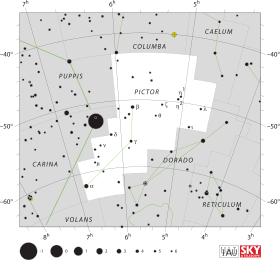HD 40307
| Ascension droite | 05h 54m 04,2410s[1] |
|---|---|
| Déclinaison | −60° 01′ 24,492″[1] |
| Constellation | Peintre |
| Magnitude apparente | 7,147[2] |
Localisation dans la constellation : Peintre | |
| Type spectral | K2.5V[3] |
|---|---|
| Indice B-V | 0,93[2] |
| Vitesse radiale | +31,265 km/s[4] |
|---|---|
| Mouvement propre |
μα = −52,423 mas/a[1] μδ = −60,151 mas/a[1] |
| Parallaxe | 77,272 7 ± 0,027 6 mas[1] |
| Distance | 12,941 2 ± 0,004 6 pc (∼42,2 al)[1] |
| Masse | 0,71 à 0,78 M☉ |
|---|---|
| Rayon | 0,71 ± 0,01 R☉[1] |
| Luminosité | 0,258 L☉[1] |
Désignations
HD 40307 est une étoile située à 42,2 années-lumière[1] dans la constellation du Peintre (visible depuis l'hémisphère sud). Elle est légèrement plus petite que le Soleil.
Système planétaire
En , au congrès Super Earths 2008 de Nantes, des astronomes européens de l'Observatoire européen austral (ESO) dont Michel Mayor ont annoncé qu'ils avaient découvert trois « super-Terres » en orbite autour de l'étoile[5]. Les trois planètes (HD 40307 b, HD 40307 c et HD 40307 d) ont été détectées avec le spectrographe High Accuracy Radial velocity Planet Searcher (HARPS)[5].
En novembre 2012, trois nouvelles planètes ont été annoncées[6] autour de l'étoile HD 40307. Toutes les trois sont des super-Terres et la dernière se trouve dans la zone habitable du système.
| Planète | Masse | Demi-grand axe (ua) | Période orbitale (jours) | Excentricité | Inclinaison | Rayon
|
|---|---|---|---|---|---|---|
| HD 40307 b | ≥ 4,0 M🜨 | 0,046 8 | 4,312 3 | 0,20 | ||
| HD 40307 c | ≥ 6,6 M🜨 | 0,079 9 | 9,618 4 | 0,06 | ||
| HD 40307 d | ≥ 9,5 M🜨 | 0,132 1 | 20,432 | 0,07 | ||
| HD 40307 e | ≥ 3,5 M🜨 | 0,188 6 | 34,62 | 0,15 | ||
| HD 40307 f | ≥ 5,2 M🜨 | 0,247 | 51,76 | 0,02 | ||
| HD 40307 g | ≥ 7,1 M🜨 | 0,600 | 197,8 | 0,29 |
Notes et références
- (en) A. G. A. Brown et al. (Gaia collaboration), « Gaia Data Release 2 : Summary of the contents and survey properties », Astronomy & Astrophysics, vol. 616, , article no A1 (DOI 10.1051/0004-6361/201833051, Bibcode 2018A&A...616A...1G, arXiv 1804.09365). Notice Gaia DR2 pour cette source sur VizieR.
- (en) HD 40307 -- High proper-motion Star sur la base de données Simbad du Centre de données astronomiques de Strasbourg.
- (en) R. O. Gray et al., « Contributions to the Nearby Stars (NStars) Project: spectroscopy of stars earlier than M0 within 40 pc-The Southern Sample », The Astronomical Journal, vol. 132, no 1, , p. 161–170 (DOI 10.1086/504637, Bibcode 2006AJ....132..161G, arXiv astro-ph/0603770)
- (en) C. Soubiran et al., « Gaia Data Release 2. The catalogue of radial velocity standard stars », Astronomy & Astrophysics, vol. 616, , p. 8, article no A7 (DOI 10.1051/0004-6361/201832795, Bibcode 2018A&A...616A...7S, arXiv 1804.09370)
- Moisson de planètes extrasolaires, dont plusieurs super-terres !, Futura-sciences, 17 juin 2008.
- « Habitable-zone super-Earth candidate in a six-planet system around the K2.5V star HD 40307 », 8 novembre 2012.


